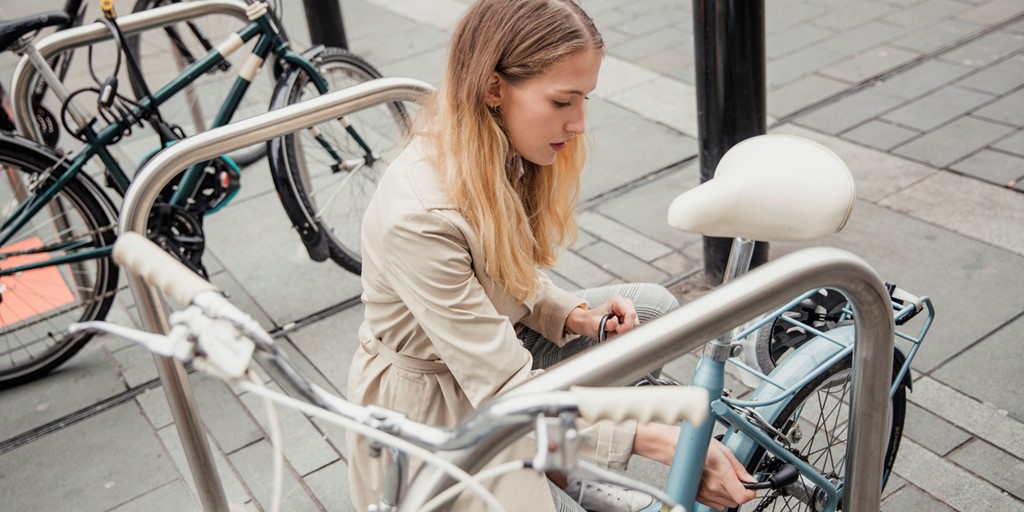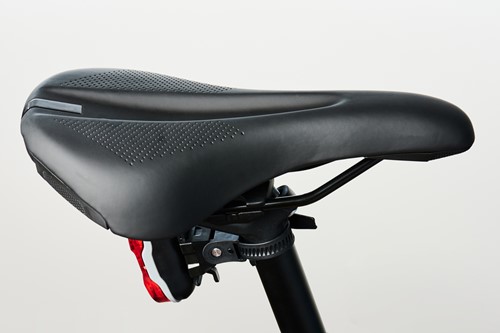How To Lock Your Bike Safely And Securely: Everything You Need To Know

When lockdown restrictions were introduced in 2020, thousands of people across the UK bought a bike and got into cycling. Halfords saw ‘unprecedented demand’ for its bicycles and cycling-related products in October 2020, with the retailer’s sales increasing 46%.
However, this means newer cyclists may be unaware of the correct measures required to keep bikes safe. Therefore, many more bike owners could be susceptible to theft by not knowing how to lock a bike safely and securely.
But if you’re new to cycling, fear not. We outline the seven things you need to consider when locking up your bike to keep it safe.
Table of contents
Lock your bike to something secure and sturdy
Use two different locks
Locking technique
Location
Removing accessories
GPS trackers
Bike covers
1. Lock your bike to something secure and sturdy
The number one rule when it comes to locking up your bike is to always secure it to something that cannot be moved, lifted, or broken. Your bike could be stolen within minutes if it isn’t secured in this way.
You should use appropriate bike sheds if possible, or ideally any bike rack that’s cemented into the ground. Large fencing may look sturdy, but a bog-standard pair of wire cutters could cut through easily, meaning a thief could easily wheel your bike away.
In addition to this, trees are not suitable locking points for bikes. Small trees can be easily snapped, bent, cut or removed from the soil. The thieves in the video above may be taking their time, but this clearly shows how determined people can be to steal a bike.
A good tip to remember is that your bike is only as secure as what you’re attaching it to, so always look for something immovable.
2. Use two different locks
If you use two different locks to secure your bike, a thief will need to use two different types of tool to prise them open.
While it’s possible, it’s highly unlikely a thief will carry several high-end tools for a multitude of locks. – is a worthy opponent for any bike thief.
A U-lock – or D-lock in some cases – is a specific type of lock, consisting of a strong metal U-shaped ring. The U part of the lock attaches to a crossbar section, and for this reason these locks are also called D-locks.
You must have the appropriate lock based on your bike’s value. To help you select the right one, we’ve selected a range of recommended locks for different bike values. If you’re still unsure about which lock is best for you, check out our simple approved locks guide.
3. Locking technique
What’s the point in spending money on a good bike lock if you don’t use it properly? You could buy the best lock on the market, but it won’t be fit for purpose if your locking technique isn’t up to scratch.
Lock the frame together with the front wheel and back wheel to the secure object you have selected. If you only have one lock, it’s best to remove the front wheel and secure both wheels together with the frame.
Ensure the U-lock is securely and tightly fastened between the bike and object you have locked it to. Doing this will make it difficult for your bike to be stolen, as it will remove any possible leverage to force open the lock.
4. Location
The location in which you’re leaving your bike is incredibly important when you’re leaving it for a sustained period. Thieves operate in unlit, discreet areas, so avoid locations like these at all costs.
Choose a well-lit location where plenty of people are passing daily. To be extra safe, try to find somewhere that has CCTV in the area.
You should also remember that pedestrians have the right of way. This means your bike could be removed if it obstructs access in public areas. In some cases, your bike may be impounded, only to be released with a fee.
When you’re at home, avoid keeping your bike in a wooden shed, as these are often easily broken into.
If you live in a flat, avoid leaving your bike in a communal hallway. It can be tempting to lock your bike to a staircase railing or something similar, but a thief could potentially reach it. Your property may come with a communal bike storage facility. If it does, make sure it’s fit for purpose by double-checking with property management. If it isn’t safe, you should contact your property management company and request improvements that it could make to the facility.
5. Removing accessories

If you can, remove all accessories from your bike when you’re not riding it, to help make it less appealing to thieves.
Having your seat, lights, or wheels looted by a thief can be almost as bad as the whole thing being taken, so it’s a good idea to remove them.
Removing the seat, for example, makes it difficult for a thief to discreetly ride off on your bike.
If it’s impossible to take off your accessories, consider using security bolts on your wheels, seat and even handlebars.
6. GPS trackers
Consider using GPS trackers on your bike. The best bike GPS trackers can be the difference between finding your stolen bike and, unfortunately, never seeing it again.
However, be wary of giving away your exact location on apps like Strava day-to-day. Try to use the enhanced privacy settings. This allows you to determine who can follow you and view your profile.
7. Bike covers
A good quality bike cover will not only keep your bike dry but also out of sight.
If you secure your bike in a communal area like a town or city centre, thieves tend to overlook covered bikes. A thief won’t want to be rummaging around underneath a bike cover, attracting unwanted attention and increasing their chances of getting caught.
Bike covers are often pretty cheap, so it’s a worthy investment considering the price of your bike.
However, we wouldn’t recommend leaving your bike in the garden with a cover over it. Thefts from gardens are extremely high, so your bike should be kept in a more secure location such as the house or a garage.
Having your bike stolen is a worry we all share. However, taking out our insurance cover is one way to help put your mind at ease.
Our specialist cycling insurance protects your bike and cycling accessories against damage, theft, and loss, both in and out of the home. We also provide Personal Accident cover if you’re involved in a cycling accident that results in permanent disability or death. This covers physiotherapy, broken bones, hospitalisation and emergency dental expenses relating to your cycling accident.
Click the link above to find out more about our cycling insurance or get an instant online quote and see what we can do for you.
Related articles
10 Tips For Cycling In A City
How To Make Sure Your Cycling Insurance Claim Is Successful
Where Do Cyclists Feel Most At Risk?







